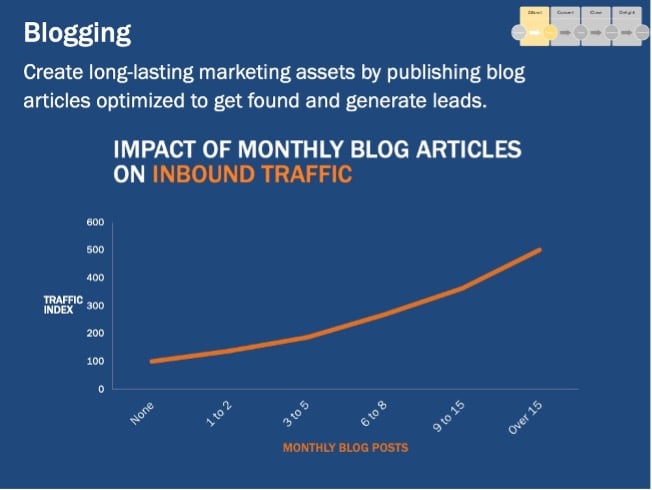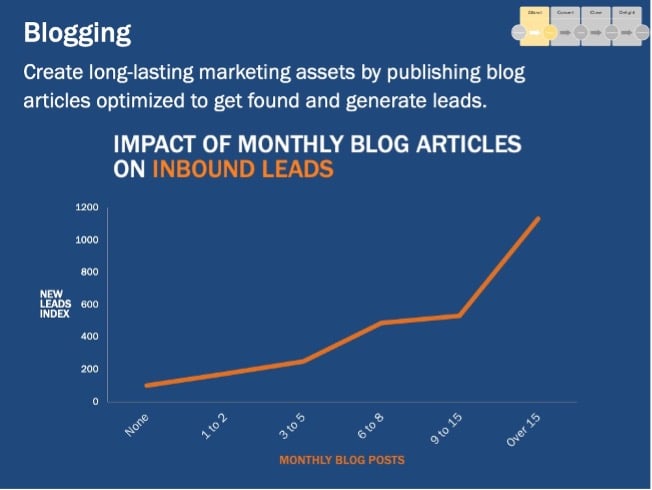
Many businesses use content marketing to spread their message to their prospects and customers. Blogging, email, and social media let businesses become their own media outlets by publishing branded content that captures the attention of their potential customers by delivering quality information that answers the questions they have during their buying cycle.
A business blog is an online publication that contains articles about your company, its products, and its services. Business blog content can support your strategic marketing goals by attracting website visitors who are interested in your content. Research shows that blogging can generate 55% more site traffic and 97% more inbound links. The key to successful blogging is delivering quality information that will both inform and engage your customer base.
A business blog walks the fine line between providing valuable information about your company and its products or services while still supporting your business growth strategy. Because it often has different goals, there some distinct best practices that distinguish business blogs from personal or media blogs.
Here are some best practices to help make your business blog a "must read" key element of your content marketing program.
Think like a publisher
A business blog is like a publication where you control the message. Its aim is to provide the most relevant information to your audience. As with any publication, this requires a bit of research. Think of how can you help answer the questions and address the concerns your ideal customer might have? Those talking points are the basis for blog articles that will appeal to your customers and drive traffic to your blog.
Find the time for content creation
If you expect your business blog to be effective, you should commit to creating quality content at least once per week (at minimum). Content creation does require time and resources, but the effort you put into your content will eventually pay off. See our "10 Ways to Fuel Inspiring Topics for Inbound Marketing Content," for some helpful tips.
Make sure everyone supports the blog
f only one person is responsible for writing all your articles, that person will burn out fast. The best business blogs are supported by a team including marketing, product development, and customer service representatives. One effective strategy for content creation is to interview the many subject matter experts in your company. For example, ask Customer Service Representatives what support questions they get asked frequently, or sales reps what objections they get most often during their sales calls. Writing blog articles about these topics gives everyone involved a voice in your company blog and makes the task of frequent blog writing a bit less arduous.
Don't forget essential on-page SEO
SEO (search engine optimization) is important for every business website, and a blog is no different. Blog articles signal to search engines that your business is an authority on the topics related to your industry. As a result they will rank your site higher on search engine results pages.
Focus on non-branded keywords
To rank well in search engines, it is necessary to include keywords in the content of your blog. Non-branded keywords are those related to your company's product and services, but do not actually mention your company by name. Avoiding terms such as "our product" or "our service" will present your content as a voice of authority, instead of a sales pitch. When it comes to keywords, a little goes a long way. Pick one focus keyword per blog and use it, and a few variations sparingly in the title, section header and body copy.
Blog frequently
To grow your business, you need to engage with your customers and potential customers online, especially when they’re ready to make a purchase. The best way to do this is by writing frequent blog posts that provide answers to the many questions they may ask on a Google search. By providing readers with valuable information in a professional and engaging way, they will be more likely to see you as a trusted source of information, which in turn will lead to increased traffic and leads. Research from HubSpot shows spikes in website traffic when a company publishes just one new blog each week.

Their research also showed a steep increase in leads when publishing increased to 2 or 3 articles per week.

Include relevant calls-to-action
For your readers, your blog is a stepping-stone to even more of the great information they want. Since they’ve clicked through to your article from a search engine, it’s a perfect opportunity to offer them more of what they came to you for by linking to other similar content that can further improve their experience. Your reader gets more of the information they came for, and, if you require some contact information in exchange for the content, you get a lead.
Engage in conversations with readers
Occasionally, readers may leave a comment on your blog. Read and respond to reader comments and questions in a timely manner to let them know you're listening. This can be as simple as "thanks for the feedback!" when someone shares a link to your post. Answering their comments reassures readers that they are welcome on your site and that you truly care about their opinions.
Make your blog easy to navigate
Busy readers often scan an article before deciding whether to read it in full. Keeping this in mind, you should use headings and bullet points when possible. This will make it easier for them to identify key topics without having to read every word. You can also provide links within articles so that readers can skip ahead if they're interested in your thoughts on a specific topic.
Include images and videos
One way to make your blog posts more engaging is by including pictures and videos. Images should be relevant to the content of your blog post and be optimized for the best viewing quality and small file size. Videos can be especially effective when they're related to the topic at hand but are short enough so that they are not an intrusion on the readers’ time.
Follow other industry bloggers and writers
Connect with other bloggers in your industry. They could be posting similar topics, or they may post their content on different networks than you. Find ways to relate with the popular industry bloggers by sharing your article with them and vice versa. Search for blogs that are like yours in terms of style and tone, then establish partnerships with these sites by providing them with some of your content in exchange for a link back to your website.
Make your blog easy to share
Make use of social media sharing tools such as Twitter & Facebook social sharing plugins. These are free and easy to implement, and they will allow your blog readers to share the content of your post on their own social networks.
Add an RSS feed
An RSS (really simple syndication) feed is an online tool that notifies readers about newly published content. It is an alternative to subscribing to your blog with email. The RSS feed may then be pulled into a personalized content aggregator.
Blogs provide a great opportunity to promote your business and keep your brand at the forefront of your customers’ minds. Your blog can help build your customer relationships by including their thoughts and opinions in your posts. Contact Heinzeroth Marketing Group to discuss how a content marketing plan can attract website visitors and convert leads and customers for your business.
